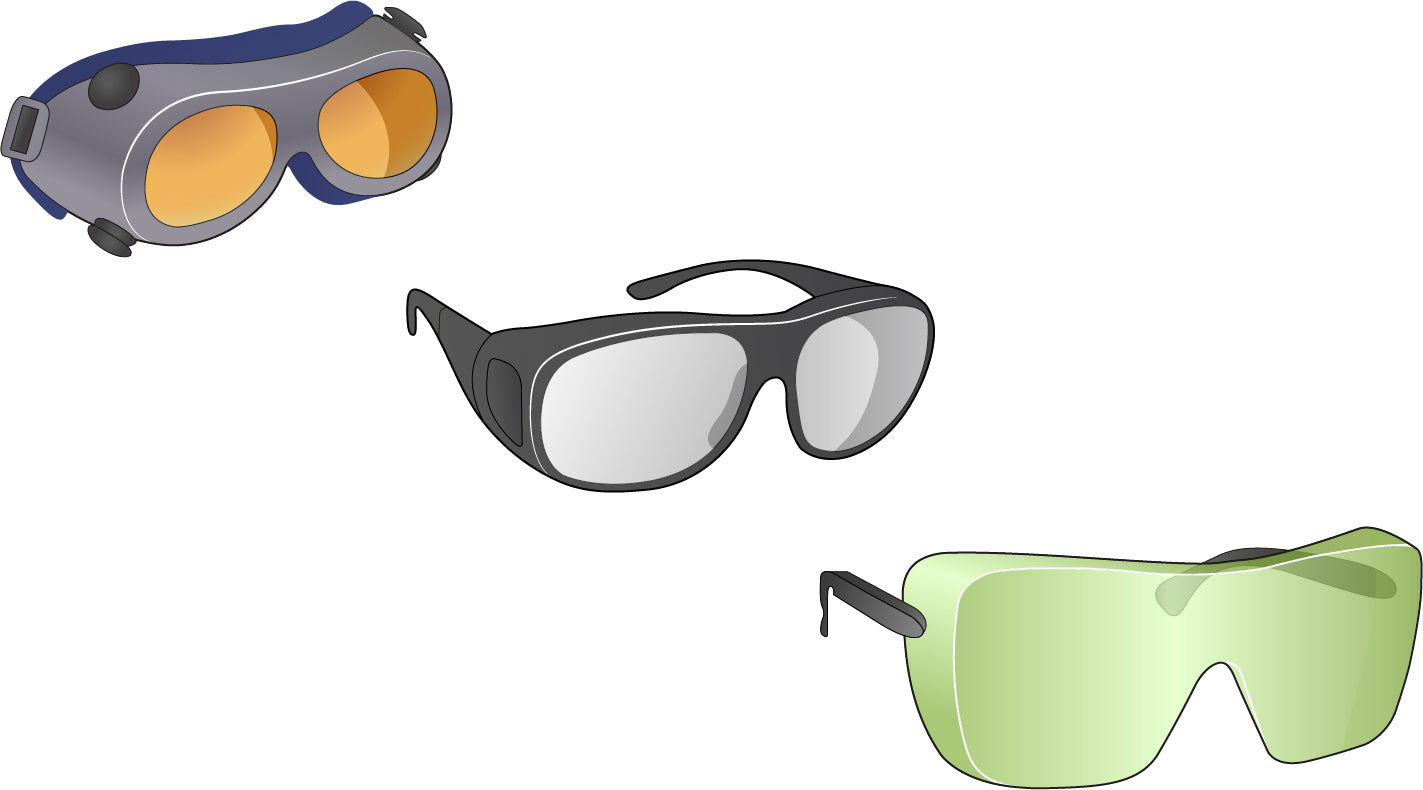To understand what laser safety glasses to purchase, the most important parameter is your laser's wavelength (or wavelength range). Often, a laser has two wavelengths affiliated with it:
- The aiming beam wavelength - the aiming beam is typically "eye safe" | depicted in the image below as red
- The operating beam wavelength - the operating beam requires proper laser safety protection | depicted in the image below as green

The aiming beam is to aid the user in positioning the operating laser beam. Generally, the aiming beam will be low powered and typically red. A common use case for an aiming beam is a laser pointer.
If you are in doubt whether or not your aiming beam is eye-safe for diffused viewing, please check with your laser safety officer or call us before making any assumptions. Recently our team has come across wavelengths utilized for aiming beams that are inappropriate without proper laser safety protection. Never look at any laser directly - including the aiming beam (stand behind the beam while viewing it), and do not bring your eyes near the axis during alignment or any other operation with lasers. All laser safety PPE is for unintentional direct and diffused viewing only. Proper laser safety is to never look directly at a laser beam; if you are hit with any laser in the eye, look away immediately. More information on the aiming beam vs operating beam here.
2) Level of protection: what protection level is needed is premised on the laser's output. by looking for the recommended Optical Density (OD), asking your Laser Safety Officer, or feel free to give us a call at 1-866-650-6926 and we can assist. The needed OD is ultimately a function of both the laser being used, and what the laser needs to be reduced to. This is known as the Maximum Permissible Exposure ("MPE") based on several parameters mentioned here.
Below we've illustrated what the laser safety lens fundamentally needs to accomplish for proper laser safety:

Optical Density: This refers to the amount of light attenuated[i] by a lens and ultimately let through to hit the eye. Different lasers (and corresponding wavelengths) have different impact on the human eye (the ANSI has created standards and published them based on research). If there is any difficulty in knowing the appropriate optical density needed for your glasses or laser safety protection, give us all call at 1-866-650-6926 or 866-650-6926. We have included a diagram to aid you in common industry notation. Kindly note that some assumptions have been made for diagrammatic purpose (the photons depicted are not drawn to scale). Finally, be sure to reach out to us if there is any uncertainty.

For more information on optical density, see here.
Visibility Light Transmission (VLT) – Color and visibility of specific color ranges often are significantly affected by laser glasses and goggles. Think about sunglasses - when wearing sunglasses to block the sun, (often less expensive) sunglasses do an effective job of blocking the sun. However, everything is much more difficult to see because not a lot of light generally is coming through. Other times with (typically more expensive) sunglasses, the sun is blocked and everything else looks very similar to how it would without the glasses. The image below is a relative comparison of visual light transmission.

Frames

The 10-Frame Fit-over is our best-selling frame by a decisive margin - it is typically the most economical solution for labs looking to buy laser eyewear that will fit everyone reducing expense for individual-specific protective eyewear. In almost all situations that are not atypical (for e.g.; fitting eyewear underneath a face shield etc.), this frame is highly recommended when the choice is polycarbonate glasses.
35-Frame Spectacle fits large heads and faces. Fits over most standard prescription glasses. Pros include high comfort and side-protection with a wide view of vision. This is our second most popular frame and is our best option for Glass and Dielectric-Coated glasses.
Laser safety glasses protect against lasers and fall into three primary categories/material:
- Polycarbonate
- Glass
- Dielectric Coated
Below is a table to display generalize trade-offs of different laser safety glasses and goggles:
| Polycarbonate | Glass | Dielectric Coating | ||
 |
 |
 |
||
| Weight | Lighter | Heavier | Heavier | |
| Price | Lower | Medium | Higher | |
| Wavelength /laser category | Ultra-Violet, Visible Light, Near and Far Infrared (IR) | Infrared | Depends (All over the electromagnetic spectrum) |
For our full laser safety glasses offering, click here.



